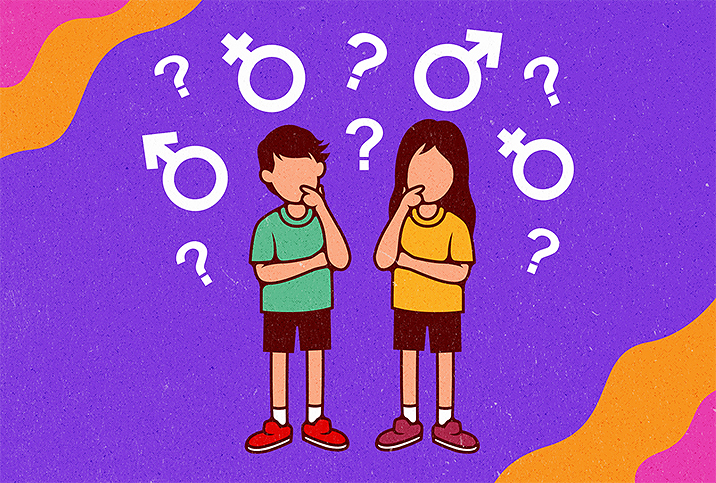The Truth About 'Blue Waffle Disease' and Its Symptoms

The 2010s produced the "Dirty Grandpa" movie, jeggings and the "blue waffle disease" hoax. Unfortunately, while the first two are in our rearview mirror, the latter has stuck around.
Blue waffle disease is an internet hoax of the Urban Dictionary genre. A photo, or more accurately, photos, of what appeared to be a blue-tinged vulva—colloquially called a "blue waffle"—began circulating on websites in 2010, depicting a fictional sexually transmitted infection (STI) that involved a symptom that caused the area around the vagina to turn blue.
In 2013, one New Jersey lawmaker even referred to blue waffle as a public health crisis that was "10 times greater at this point than the AIDS virus."
While blue waffle is not a real disease, the fact people still think it's credible is a damning reflection of current STI/STD education.
What is blue waffle disease?
Before delving into how people—including many grown adults with vaginas—could be led to believe this is a real disease, let's ask ourselves some important questions:
Is blue waffle disease a real STI?
Blue waffle disease is not a real condition. It does not turn a vagina, colloquially known as a pussy, blue (nor red nor dirty, for that matter). It does not include any other symptom that involves the penis, either.
How did the blue waffle hoax start?
According to the Verywell Health website, internet pranksters started spreading online rumors in 2010 of a (fake) STI that turned the vaginal area blue, also claiming the condition manifested as burning, itching, lesions and a smelly discharge.
What's actually happening in the blue waffle photo?
There is no STI that causes the vulva to turn blue, so the photo is likely photoshopped or a cropped photo of another skin condition.
The sad state of STI education, from vagina to penis
Ridiculous sex rumors were around long before locker rooms and internet forums. Still, it's a sad state of affairs when they linger, even when they could be dispelled by a few Google searches.
Although parental support for sex education in middle and high school polls at more than 90 percent nationally, and the majority of parents support coverage of STIs, sexuality and birth control, only 39 states and the District of Columbia mandate some form of sex and/or HIV education.
Sex education remains left to individual states and school districts, leaving plenty of room for inconsistency. The 2018 Centers for Disease Control and Prevention (CDC) School Health Profiles reported that less than half of high schools and less than one-fifth of middle schools cover all 20 sex education topics the CDC recommends as critical, including basic information on how HIV and other STIs are transmitted.
"Americans are, at this point, in a kind of uniquely bad position for STI awareness and sex ed," said Laura Boyle, an author and a sex educator based in Connecticut.
Boyle, who teaches community sex ed outreach classes, noted there is a continued emphasis on abstinence in the vast majority of schools that teach biologically correct sex ed, which may be a contributing factor in the rise of STIs among young people.
Combined cases of gonorrhea, syphilis and chlamydia reached an all-time high in 2018 after rising for the fifth year in a row, according to the CDC. From 2014 to 2018, cases of chlamydia, one of the most prevalent STIs, increased by 15 percent, and gonorrhea and syphilis cases by 35 percent and 50 percent, respectively, the CDC reported.
This rise in STIs is likely the result of the concerted effort toward pro-abstinence or abstinence-only sex ed policies from 1995 to 2002.
"Now the people who were like 13 or 14 when those rules started coming into effect are 40," Boyle said. "We've got an entire generation of adult Americans who may—by mandate—lack this information."
The invisible danger of real, untreated STIs, not the fake blue waffles
Comedian Ali Wong once referred to HPV as a "ghost that jumps out of men's penises that either gives you cancer or goes away on its own."
While people may panic at seeing the visceral symptoms depicted in the so-called blue waffle photo, many common STIs, such as HPV, gonorrhea and chlamydia, often don't have any outwardly visible physical symptoms. Instead, they significantly compound the likelihood of other serious health problems:
- Most cases of chlamydia in women don't show symptoms, but if left untreated, chlamydia can turn into pelvic inflammatory disease and cause infertility, tubal pregnancies and higher risks of contracting other STIs, such as HIV.
- Untreated gonorrhea causes similar problems and can turn into a life-threatening blood infection.
- Untreated STIs in pregnant women can jeopardize their pregnancies and be passed on to the infants.
STIs are also not exclusive to penis-in-vagina or penis-in-anus sex. Boyle, who recently hosted an STI awareness workshop, emphasized that different forms of sexual activity carry different risks, depending on the STI and the amount of interaction.
For example, gonorrhea is often passed among LGBTQIA+ people with vaginas who exclusively have sex with each other because they didn't know that acts like scissoring or oral sex could transmit disease.
"Even in the states you get 'comprehensive sex ed,' it doesn't cover situations that aren't a man and woman having sex," Boyle said. "And while barriers like condoms are great, there are some STIs that aren't affected by barriers, or it only lowers the chance."
Teaching about sex, not just procreation
Perhaps the reason even the more comprehensive sex ed courses shy away from the potential STI rates of different sex acts is that what we think of as "sex ed" tends to focus on biological processes, such as pregnancy and procreation. Very rarely do they include non-cisgender heterosexual sexuality or any discussion of sexual pleasure. However, procreation tends to rank low on the list of reasons people—particularly high schoolers and college students—have sex.
More than 24 percent of LGBTQIA+ students never received sex education in school, and of the people who did, only 8.2 percent said it was LGBTQIA+ inclusive, according to the Gay, Lesbian and Straight Education Network (GLSEN) Research Institute's 2019 National School Climate Survey. However, 85 percent of parents support discussing sexual orientation as part of sex ed in high school and 78 percent support it in middle school.
"Some of it is just choosing not to lean into statements of shame that we get as teenagers and children, right?" Boyle said.
By not including pleasure in the conversation and talking about sex only in terms of pregnancy and fear, sex education misses out on a variety of potential risks and leaves older teens and young adults woefully unprepared to take care and take charge of their sexual health.
Education is key to our understanding of STIs.
"These are regular risks that come with this adult behavior that I want to engage in," Boyle said, explaining how to talk about STIs with young adults. "Everything we do in life comes with risks. You're at much greater risk getting in your car every day than you are having sex with someone, pretty much no matter what. You need to know the risks to decide, 'Well, this is what I can and can't change, do I accept this risk or not?'"
Education is key to our understanding of STIs. As the admittedly non-medical-professional comedian George Carlin once said, "Don't just teach your children to read. Teach them to question what they read. Teach them to question everything."
Fake information on the internet is not exempt from this advice.
The origins of the blue waffle may have started as a joke and that should have been that—except some people decided it was real. While there are STIs and STDs that require close attention, hoaxes like the blue waffle need to be fact-checked by consulting your medical provider and, long term, stomped out by improving our education about sexually transmitted infections.




















